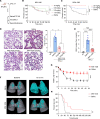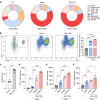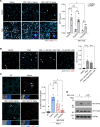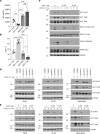PTP1B inhibitors protect against acute lung injury and regulate CXCR4 signaling in neutrophils
- PMID: 35866483
- PMCID: PMC9431713
- DOI: 10.1172/jci.insight.158199
PTP1B inhibitors protect against acute lung injury and regulate CXCR4 signaling in neutrophils
Abstract
Acute lung injury (ALI) can cause acute respiratory distress syndrome (ARDS), a lethal condition with limited treatment options and currently a common global cause of death due to COVID-19. ARDS secondary to transfusion-related ALI (TRALI) has been recapitulated preclinically by anti-MHC-I antibody administration to LPS-primed mice. In this model, we demonstrate that inhibitors of PTP1B, a protein tyrosine phosphatase that regulates signaling pathways of fundamental importance to homeostasis and inflammation, prevented lung injury and increased survival. Treatment with PTP1B inhibitors attenuated the aberrant neutrophil function that drives ALI and was associated with release of myeloperoxidase, suppression of neutrophil extracellular trap (NET) formation, and inhibition of neutrophil migration. Mechanistically, reduced signaling through the CXCR4 chemokine receptor, particularly to the activation of PI3Kγ/AKT/mTOR, was essential for these effects, linking PTP1B inhibition to promoting an aged-neutrophil phenotype. Considering that dysregulated activation of neutrophils has been implicated in sepsis and causes collateral tissue damage, we demonstrate that PTP1B inhibitors improved survival and ameliorated lung injury in an LPS-induced sepsis model and improved survival in the cecal ligation and puncture-induced (CLP-induced) sepsis model. Our data highlight the potential for PTP1B inhibition to prevent ALI and ARDS from multiple etiologies.
Keywords: Cell Biology; Neutrophils.
Conflict of interest statement
Figures






Similar articles
-
Glycyrrhizin alleviates sepsis-induced acute respiratory distress syndrome via suppressing of HMGB1/TLR9 pathways and neutrophils extracellular traps formation.Int Immunopharmacol. 2022 Jul;108:108730. doi: 10.1016/j.intimp.2022.108730. Epub 2022 Mar 24. Int Immunopharmacol. 2022. PMID: 35354111
-
The HDL from septic-ARDS patients with composition changes exacerbates pulmonary endothelial dysfunction and acute lung injury induced by cecal ligation and puncture (CLP) in mice.Respir Res. 2020 Nov 4;21(1):293. doi: 10.1186/s12931-020-01553-3. Respir Res. 2020. PMID: 33148285 Free PMC article.
-
Small Immunomodulatory Molecules as Potential Therapeutics in Experimental Murine Models of Acute Lung Injury (ALI)/Acute Respiratory Distress Syndrome (ARDS).Int J Mol Sci. 2021 Mar 4;22(5):2573. doi: 10.3390/ijms22052573. Int J Mol Sci. 2021. PMID: 33806560 Free PMC article.
-
A Three-phase Approach for the Early Identification of Acute Lung Injury Induced by Severe Sepsis.In Vivo. 2016 Jul-Aug;30(4):341-9. In Vivo. 2016. PMID: 27381595 Review.
-
A Narrative Review: The Role of NETs in Acute Respiratory Distress Syndrome/Acute Lung Injury.Int J Mol Sci. 2024 Jan 25;25(3):1464. doi: 10.3390/ijms25031464. Int J Mol Sci. 2024. PMID: 38338744 Free PMC article. Review.
Cited by
-
Transfusion-Related Acute Lung Injury: from Mechanistic Insights to Therapeutic Strategies.Adv Sci (Weinh). 2025 Mar;12(11):e2413364. doi: 10.1002/advs.202413364. Epub 2025 Jan 21. Adv Sci (Weinh). 2025. PMID: 39836498 Free PMC article. Review.
-
Myeloid PTP1B deficiency protects against atherosclerosis by improving cholesterol homeostasis through an AMPK-dependent mechanism.J Transl Med. 2023 Oct 12;21(1):715. doi: 10.1186/s12967-023-04598-2. J Transl Med. 2023. PMID: 37828508 Free PMC article.
-
PTP1B phosphatase dampens iPSC-derived neutrophil motility and antimicrobial function.J Leukoc Biol. 2024 Jun 28;116(1):118-131. doi: 10.1093/jleuko/qiae039. J Leukoc Biol. 2024. PMID: 38417030 Free PMC article.
-
Systematic Review of Interleukin-35 in Endothelial Dysfunction: A New Target for Therapeutic Intervention.Mediators Inflamm. 2025 Feb 12;2025:2003124. doi: 10.1155/mi/2003124. eCollection 2025. Mediators Inflamm. 2025. PMID: 39974277 Free PMC article.
-
PI3Kγ promotes neutrophil extracellular trap formation by noncanonical pyroptosis in abdominal aortic aneurysm.JCI Insight. 2024 Jul 18;9(16):e183237. doi: 10.1172/jci.insight.183237. JCI Insight. 2024. PMID: 39024551 Free PMC article.
References
Publication types
MeSH terms
Substances
Grants and funding
LinkOut - more resources
Full Text Sources
Other Literature Sources
Medical
Molecular Biology Databases
Research Materials
Miscellaneous

